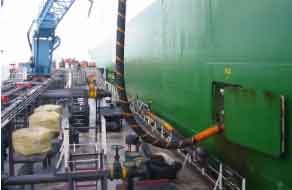The cost of a barrel of oil continues to soar, ending the day Tuesday at about $130, up from $98 before the Russian invasion of Ukraine. That after a sharp jump in February on anticipation of the conflict. Many are predicting oil prices soon of as much as $200 per barrel.
Supply Chain Digest Says... |
 |
|
A garden furniture retailer executive said he could not pass on to consumers a 30% increase in the cost of the company’s made-in-China products due to soaring shipping costs. |
|
 |
|
What do you say? |
|
| Click here to send us your comments |
|
| |
|
| Click here to see reader feedback |
|
|
|
The rise in oil naturally enough drives similar increases in gasoline prices for consumers, now on average over $4.00 gallon in the US this week.
But the rising oil prices also push up the costs of fuels for freight transport much less visible to consumers. That would include the costs of low-sulphur bunker fuel ships without sulphur scrubbers use for power.
Costs for that fuel have risen by a third since the end of February to about $1,000 per ton. That in turn adds substantially to the costs to operate a container ship, for which fuel is second only to labor costs in terms of variable operating expense.
What will be the impact? There are several, some of which were identified in an article this week on theloadstar.com web site.
First, carriers will of course try to recoup the costs of rising bunker fuel from shippers in the form of fuel surcharges. There will be pushback from shippers as always, and some contracts include the price of fuel in the container rate. But in general ocean shippers will be looking at big increases in fuel charges, on top of already extremely high container shipping rates.
To reduce the impact of rising fuel costs, shippers should expect to see expanded use of “slow steaming” practices by the carriers, which will extend already elongated delivery times and have the net effect of reducing capacity.
The rising bunker fuel costs will also change the math in the analysis by ocean carriers of the relative merits of installing expensive scrubbers on their ships versus buying the now more expensive low sulphur fuel to meet recent rules from the International Maritime Organization that limit sulphur emissions from cargo ships. The ROI for scrubbers will increase, though the downtime to execute the retrofits is also costly.
(See More Below)
|
CATEGORY SPONSOR: SOFTEON |
|
|
|
|
|
 The good news of sorts? Rising costs in terms of both container rates and fuel costs may be getting to the point that demand droops, perhaps allowing the container shipping sector to return to something like normal times after 18 months of chaos and delays. The good news of sorts? Rising costs in terms of both container rates and fuel costs may be getting to the point that demand droops, perhaps allowing the container shipping sector to return to something like normal times after 18 months of chaos and delays.
TheLoadstar notes that it has "seen evidence that orders from Asia of low-value high-cubed commodities have been cancelled, as the eight-to-ten-fold increase in shipping costs since the start of the pandemic has made retailing these products unsustainable.”
It cites the example of a garden furniture retailer executive who said he could not pass on to consumers a 30% increase in the cost of the company’s made-in-China products due to soaring shipping costs, and had decided to cancel orders until rates came down
The impacts of rapidly rising fuel costs for container ships will be many.
What are your thoughts the impact of soaring bunker fuel cost? Let us know your thoughts at the Feedback section below
Your Comments/Feedback
|
|
Danny
Manager, IPL |
Posted on: Mar, 06 2023 |
|
| Steam Shipping Lines need to constantly work on eco friendly fuel alternatives, reducing speeds upon arrivals globally to commonly congested ports would save fuel and money helping the line, the shipper, the customer and the CO2 levels. Also, taking into consideration eco friendly innovation to the original ship designs opposed to a complete overhaul are realistic steps that need to be taking to transport containers. |
|
|

